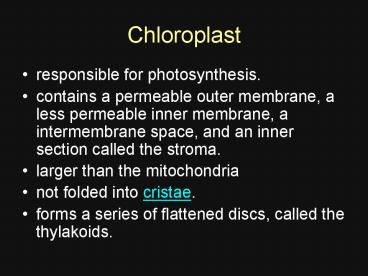Chloroplast - PowerPoint PPT Presentation
1 / 34
Title: Chloroplast
1
Chloroplast
- responsible for photosynthesis.
- contains a permeable outer membrane, a less
permeable inner membrane, a intermembrane space,
and an inner section called the stroma. - larger than the mitochondria
- not folded into cristae.
- forms a series of flattened discs, called the
thylakoids.
2
- http//www.mhhe.com/biosci/genbio/tlw2/student/olc
/graphics/johnson2tlw_s/ch08/others/mi08-04b.dcr
3
- The innermost membrane of the chloroplast is
called the thylakoid membrane. - The thylakoid membrane is folded upon itself
forming many disks called grana (singular
granum). - The "cytoplasm" of the chloroplast is called the
stroma
4
(No Transcript)
5
Chlorophyll
- Chlorophyll is a complex molecule. Several
modifications of chlorophyll occur among plants
and other photosynthetic organisms.
6
Chlorophyll a
- All photosynthetic organisms (plants, certain
protistans, prochlorobacteria, and cyanobacteria)
have chlorophyll a.
7
- Chlorophyll a absorbs its energy from the
Violet-Blue and Reddish orange-Red wavelengths,
and little from the intermediate
(Green-Yellow-Orange) wavelengths. - Chlorophyll A is the main photosynthetic pigment
in all organisms except bacteria.
8
Accessory pigments
- Accessory pigments absorb energy that chlorophyll
a does not absorb. Accessory pigments include
chlorophyll b (also c, d, and e in algae and
protistans), xanthophylls, and carotenoids (such
as beta-carotene).
9
Compare wavelength absorbed
- 1. Chlorophyll a Light to medium green. Main
photosynthetic pigment. - 2. Chlorophyll b Blue-green. Accessory Pigment.
- 3. Carotene Orange. Accessory Pigment.
- 4. Xanthophyll Yellow. Accessory Pigment.
10
Action and Absorption Spectrum
- Go to this site to learn more about these.
- Action Absorption Spectra
11
Action Spectra page 77
- The use of action spectra has been central to the
development of our current understanding of
photosynthesis. An action spectrum is a graph of
the magnitude of the biological effect observed
as a function of wavelength. Examples of effects
measured by action spectra are oxygen evolution
12
Action Spectrum page 77
13
Absorption Spectrum page 77
- An absorption spectrum the wavelengths at which
it can absorb light and enter into an excited
state. The diagram represents the absorption
spectrum of pure chlorophylls
14
- http//academic.kellogg.edu/herbrandsonc/bio111/an
imations/0053.swf
15
Photoexcitation
- When a pigment absorbs a photon, one of the
molecules electrons is elevated to an orbital
with more potential energy (this excited state
unstable). - Only photons absorbed are those whose energy is
exactly equal to the energy difference between
the ground state and the excited state. This
energy difference varies between pigments.
16
Stages of Photosynthesis page 78
- The first process is the Light Dependent Process
(Light Reactions), requires the direct energy of
light to make energy carrier molecules that are
used in the second process. - Untitled Document
- Harvesting Light
- http//www.biology4all.com/resources_library/sourc
e/61a.swf - Animation Quizzes (go to light independent
reaction) - NetLearning - Examples - Flash
17
There are two paths which can be taken
- Cyclic electron flow The simpler, involving
only photosystem 1 and generates only
ATP Animations - Non cyclic uses both systems, generates ATP and
NADPH and oxygen is released. - Light-dependent reactions (scroll down to
animations)
18
Photophosphorylation page 78 study guide
- The electron transport system is found embedded
within the thylakoid membrane and functions in
the production of ATP. The system contains
membrane-bound electron carriers that pass
electrons from one to another. As a result of
gaining an electron (reduction), the first
carrier of the electron transport system gains
energy. It uses some of the energy to pump H
into the thylakoid.
19
(No Transcript)
20
- ATP is produced from ADP and Pi when hydrogen
ions pass out of the thylakoid through ATP
synthase. This method of synthesizing ATP by
using a H gradient in the thylakoid is called
photophosphorylation. - Light reactions
- Animations
- Tutorial 8.2 Photophosphorylation
21
(No Transcript)
22
One more look
- http//www.fw.vt.edu/dendro/forestbiology/photosyn
thesis.swf
23
The Calvin cycle
- occurs in the stroma of chloroplasts
- Carbon dioxide is captured by the chemical
ribulose biphosphate (RuBP). - RuBP is a 5-C chemical.
- Six molecules of carbon dioxide enter the Calvin
Cycle producing one molecule of glucose.
24
Carbon fixation page 79
- The words "CO2 fixation" refer to the attachment
of CO2 to an organic compound each CO2 binds to
a 5-carbon ribulose biphosphate (RuBP) molecule. - Carbon dioxide fixation is catalyzed by RuBP
carboxylase (rubisco).
25
Page 79 study guide
- Read study guide on Calvin cycle
- calvin
26
- Calvin cycle
- calvin
- photosynthesis dark phase
- Garrett Grisham Biochemistry
- http//academic.kellogg.cc.mi.us/herbrandsonc/bio1
11/animations/0055.swf - Calvin Benson
27
- For each six CO2 molecules that enter the cycle
one glucose molecule is produced. - About 30 of the energy available in ATP and
NADPH is finally present in the glucose produced.
28
Comparison of Photosynthesis and Respiration
29
Limiting Factors in Photosynthesispage 81
- Temperature plays a role in affecting the rate of
photosynthesis. Enzymes involved in the
photosynthetic process are directly affected by
the temperature of the organism and its
environment
30
- Light Intensity is also a limiting factor, if
there is no sunlight, then the photolysis of
water cannot occur without the light energy
required.
31
- Carbon Dioxide concentration also plays a factor,
due to the supplies of carbon dioxide required in
the Calvin cycle stage.
32
(No Transcript)
33
- This is the chapter lecture outline for chapter
10 of your book. - Chapter Ten Extended Lecture Outline
- This review goes along with your book Chapter 10
eLearning Session
34
- PHSchool - The Biology Place

